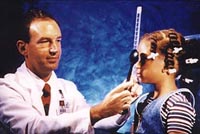Crossed-Eyes (Strabismus)

Photograph used by permission of the National Eye Institute, National Institutes of Health
What is strabismus?
Strabismus, a misalignment of the eyes, is one of the most common eye problems in children, affecting approximately 4 percent of children under the age of six years. The eyes (one or both) may turn inward, outward, turn up, or turn down. At times, more than one of these conditions are present. Strabismus is also called "wandering eye" or "crossed-eyes."
What causes strabismus?
Experts do not completely understand the cause of strabismus. However, strabismus results from failure of the eye muscles to work together. The brain controls the eye muscles, which are attached to the outside of each eye. There appears to be a higher incidence of strabismus in children with disorders that affect the brain, such as cerebral palsy or hydrocephalus. Strabismus may also occur later in life as a result of an illness, cataract, or eye injury.
All forms of strabismus have been found to cluster in families. Siblings and children of an individual with strabismus may have an increased chance to also develop it, however, a single inherited cause has not been identified.
What are the symptoms of strabismus?
It is normal for a newborn's eyes to move independently and at times, even cross. However, by three to four months old, an infant should be able to focus on objects and the eyes should be straight, with no turning. If you notice that your child's eyes are moving inward or outward, if he or she is not focusing on objects, and/or the eyes seem to be crossed, you should seek medical attention. Children with strabismus may also develop secondary vision loss (amblyopia, also know as lazy eye). The onset of strabismus is most common in children younger than six years of age.
The symptoms of strabismus may resemble other medical conditions. Always consult your child's doctor for a diagnosis.
How is strabismus diagnosed?
Early detection and treatment can prevent permanent visual impairment. Strabismus is diagnosed during an eye examination. Eye examinations are recommended for all children by the age of three. However, if your child is having symptoms of strabismus or other eye disorders at any age, a complete eye examination should be performed.
Treatment for strabismus
Specific treatment for strabismus will be determined by your child's doctor based on:
Your child's age, overall health, and medical history
The extent of the disease
The cause of the disease
Your child's tolerance for specific medications, procedures, or therapies
Expectations for the course of the disease
Your opinion or preference
Your child may be referred to an ophthalmologist or optometrist (eye care specialists) for treatment of this problem. Treatment may include one, or more, of the following:
Eyeglasses
Eye drops
Surgery to straighten the eyes
Eye exercises
Eye patch over the strong eye (if amblyopia is present) to improve the weak eye
Strabismus cannot be outgrown. However, early treatment can prevent visual impairment.
Connect with us:
Download our App: